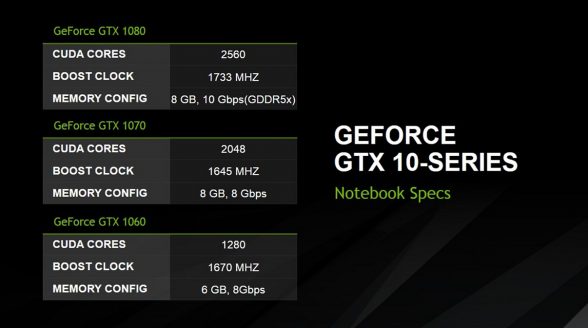With the launch of Nvidia’s Pascal based GeForce GTX 1080, GTX 1070, and GTX 1060 desktop chips now complete, Nvidia announced today that they’re bringing Pascal to the notebooks as well.
Nvidia’s launch today will bring three new notebook cards to the mix, the GeForce GTX 1080, GTX 1070 and GTX 1060. These three cards will strongly highlight the importance of the move to TSMC’s 16nm FinFET fabrication process as they’re no longer the cut down versions of the desktop cards we’re used to seeing in previous generation cards.
Nvidia is also no longer advertising these as “m” GPUs given that they’re no longer less powerful compared to their desktop siblings. However, for the purposes of clarity in this article, we’ll still refer to these as mobile chips here.
Nvidia GeForce GTX 10 Series Mobile Specifications
| Model | GTX 1080 | GTX 1070 | GTX 1060 | GTX 980M | GTX 970M | GTX 960M |
|---|---|---|---|---|---|---|
| GPU | GP104 | GP104 | GP106 | GM204 | GM204 | GM107 |
| Architecture | Pascal | Pascal | Pascal | Maxwell | Maxwell | Maxwell |
| Fabrication | TSMC 16nm | TSMC 16nm | TSMC 16nm | TSMC 28nm | TSMC 28nm | TSMC 28nm |
| Clock (Core/Boost) | 1556/1733MHz | 1442/1645MHz | 1404/1670MHz | 1038MHz | 924MHz | 1097MHz |
| CUDA Cores | 2560 | 2048 | 1280 | 1536 | 1280 | 640 |
| TMUs | 160 | 128 | 80 | 96 | 80 | 40 |
| ROPs | 64 | 64 | 48 | 64 | 48 | 16 |
| Memory | 8GB GDDR5X | 8GB GDDR5 | 6GB GDDR5 | 4GB GDDR5 | 4GB/8GB GDDR5 | 4GB GDDR5 |
| Memory Interface | 256-bit | 256-bit | 192-bit | 256-bit | 192-bit | 128-bit |
| Effective Memory Clock | 10 Gbps | 8 Gbps | 8 Gbps | 5 Gbps | 5 Gbps | 5 Gbps |
| TDP | ? | ? | ? | 100W | 75W | 65W |
The flagship in the mobile lineup is the GeForce GTX 1080 (mobile), which is based on the GP104 GPU. It features a whopping 2560 CUDA cores clocked at 1556/1733MHz core/boost, 160 TMUs, 64 ROPs, and 8GB of GDDR5x running at 10Gbps on a 256-bit memory interface. Compared to the last generation counterpart, the GeForce GTX 980m, this is a huge step up bringing close to twice the amount of CUDA cores. In addition, the move to GDDR5X brings the GTX 1080 (mobile) twice the memory bandwidth of the GeForce GTX980m as well. As such, we’ll likely be seeing massive performance improvements from the GeForce GTX 1080 (mobile) over the GeForce GTX980m.
Right below the GeForce GTX 1080 (mobile) is the GeForce GTX 1070 (mobile), which is based on the GP104 GPU as well. It’s still no slouch featuring 2048 CUDA cores clocked at 1442/1645MHz core/boost, 128 TMUs, 64 ROPs, and 8GB of GDDR5 clocked at 8 Gbps running on a 256-bit memory interface. Carrying almost twice the CUDA cores as the last generation GeForce GTX970m as well as a fatter memory interface, the GeForce GTX 1070 (mobile) should see significant improvement compared to its predecessor as well.
Finally below that, there’s the GeForce GTX 1060 (mobile), which is based on the GP106 GPU. It features 1280 CUDA cores clocked at 1404/1670MHz core/boost, 80 TMUs, 48 ROPs, and 6GB GDDR5 clocked at 8Gbps running on a 192-bit memory interface. Just like the GeForce GTX 1080 (mobile) and GeForce GTX 1070 (mobile), the GeForce GTX 1060 (mobile) will get almost twice the CUDA cores as its predecessor, the GeForce GTX 960m, and a significantly fatter memory interface as well. Again, we should see some huge performance improvements here.
The Nvidia GeForce GTX 1080 (mobile), GTX 1070 (mobile) and GTX 1060 (mobile) is currently shipping and many of Nvidia’s OEM partners are expected to begin updating their product stacks with the new graphics cards onboard. With any luck, we’ll be seeing some of these new systems in the labs here as well, so stay tuned for more!







